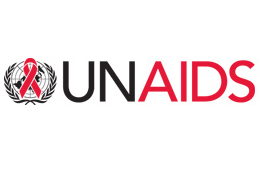The Joint United Nations Programme on HIV/AIDS (UNAIDS) is an innovative joint venture of the United Nations family which brings together the efforts and resources of 11 UN system organizations to unite the world against AIDS. The participating organizations that form UNAIDS, also called the UNAIDS Cosponsors, are (in no particular order):
- UNHCR (United Nations High Commissioner for Refugees)
- UNICEF (United Nations Children’s Fund
- World Bank
- UNESCO (United Nations Educational, Scientific and Cultural Organization)
- UN Women (United Nations Entity for Gender Equality and the Empowerment of Women)
- UNDP (United Nations Development Programme)
- UNFPA (United Nations Populations Fund)
- WHO (World Health Organisation)
- World Food Programme
- UNODC (United Nations Office on Drugs and Crime)
- ILO (International Labour Organisation)
The Joint Programme is coordinated by the UNAIDS Secretariat, headquartered in Geneva, Switzerland.
UNAIDS’ mission is to lead and inspire the world in achieving universal access to HIV prevention, treatment, care and support.
UNAIDS fulfills its mission by:
- Uniting the efforts of the United Nations system, civil society, national governments, the private sector, global institutions and people living with and most affected by HIV;
- Speaking out in solidarity with the people most affected by HIV in defense of human dignity, human rights and gender equality;
- Mobilizing political, technical, scientific and financial resources and holding ourselves and others accountable for results;
- Empowering agents of change with strategic information and evidence to influence and ensure that resources are targeted where they deliver the greatest impact and bring about a prevention revolution; and
- Supporting inclusive country leadership for sustainable responses that are integral to and integrated with national health and development efforts.
UNAIDS’ work plan is currently guided by two main documents: the UNAIDS Strategy 2011-2015: Getting to Zero, and the 2011 Political Declaration on HIV and AIDS.
The UNAIDS Strategy aims to advance global progress in achieving country set targets for universal access to HIV prevention, treatment, care and support and to halt and reverse the spread of HIV, as well as to contribute to the achievement of the Millennium Development goals by 2015. It provides a roadmap for the Joint Programme, with concrete goals marking milestones on the path to achieving UNAIDS’ vision of “Zero new HIV infections. Zero discrimination. Zero AIDS-related deaths.”
The 2011 Political Declaration on HIV and AIDS was adopted by the UN General Assembly in June 2011. The Declaration contains 10 targets including:
1. Reducing sexual transmission
2. Preventing HIV among drug users
3. Eliminating new HIV infections among children
4. 15 million accessing treatment
5. Avoiding TB deaths
6. Closing the resource gap
7. Eliminating gender inequalities
8. Eliminating stigma and discrimination
9. Eliminating travel restrictions
10. Strengthening HIV integration

